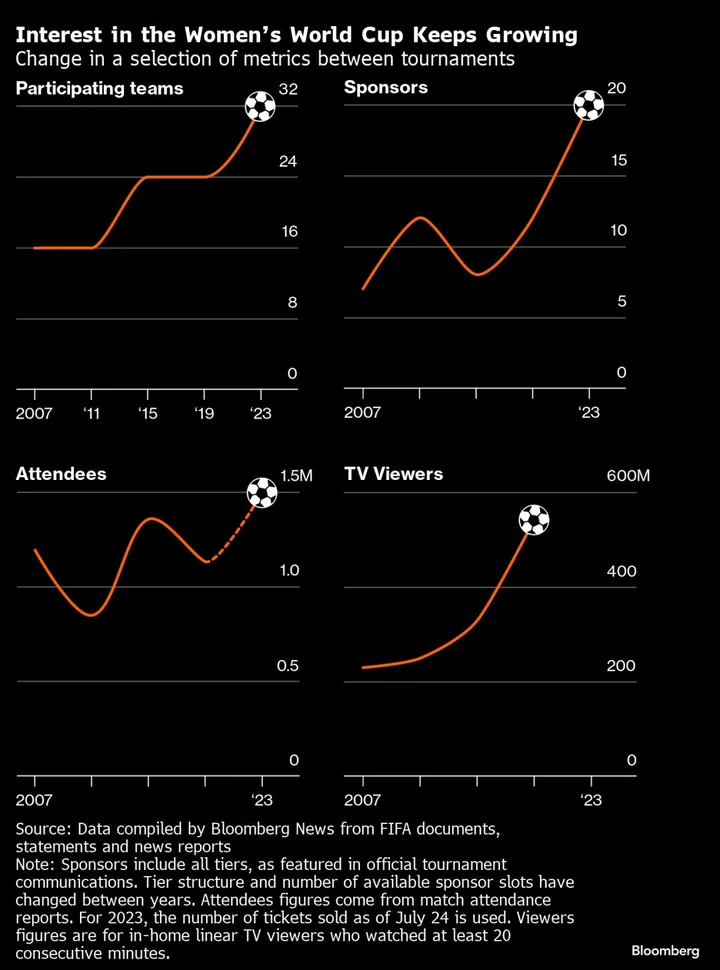The FIFA Women’s World Cup faces a huge shortfall in sponsorship compared to the men’s tournament just eight months ago, new analysis reveals, as brands continue to miss a key opportunity to reach an engaged audience.
Despite having more sponsors than ever before, it seems these partnerships aren’t yet paying off. Sponsorship revenue generated by this summer’s event is estimated at $300 million, which pales in comparison to the $1.7 billion created for the tournament in Qatar, according to research provided to Bloomberg by analytical firm Omdia.
With increased prize money, a record number of teams competing, and 1.5 million tickets sold, this is set to be the biggest and most attended Women’s World Cup in history. The headline sponsors are Unilever Plc., Budweiser and McDonald’s Corp. — but sponsorship revenue is estimated at just 18% of the men’s competition in 2022.
While there were hopes that the 2023 event, taking place in New Zealand and Australia, would bring new advertisers and bigger revenue streams for the women’s game following a hugely successful tournament in Europe the previous year, this isn’t so far reflected in the numbers. This appears to be an open goal for companies looking to reach a valuable demographic; 67% of Britons plan to watch matches while the estimated disposable income of the global viewership is £7 billion ($8.9 billion). The audience is also at near gender parity in the UK, meaning the competition could attract partnerships and endorsements from brands not traditionally associated with the men’s game.
Read More: World Cup Turns Up the Pressure for TV to Embrace Women’s Soccer
This is a problem as it could stall further investment into the game. What’s more, companies also appear to take female athletes (and their fanbase) for granted. "One of the issues I still see is brands and organizations expecting female footballers to do things for free," said Rebecca Sowden, founder of the women's sports sponsorship company Team Heroine and former New Zealand national footballer.
"In order to grow the game and the ecosystem these athletes must be valued and no matter what level be paid for their time, their association and their brand story telling power," she said.
Brands are also underestimating the reach that female footballers have on social media, another missed opportunity. While they may have fewer followers than their male counterparts, they often have greater engagement and so can influence more people, according to research by Nielsen Holdings Plc., which considered the sponsorship opportunities available to male and female stars.
Take the example of Aston Villa forward Alisha Lehmann. Her 13.9 million followers (as of the June 2023 report) makes her the most popular Swiss athlete on the platform — even more so than tennis legend Roger Federer. While her following has skyrocketed over the past year, the greatest opportunity for sponsors derives from her high engagement rate of 6.99% which translates into media value that’s a little higher than $300,000 for a social post. Real Madrid legend Sergio Ramos, by comparison, had 53 million followers that month but a low engagement rate of 1.8% means his reach is similar to Lehmann. Still, brands don’t seem as willing to put their money behind women.
“The footballers participating at World Cup 2023 are not only exceptional sports women but also social media powerhouses, capable of driving impactful conversations and fostering genuine connections with their followers,” said Jon Stainer, managing director of Nielsen Sports.
A small group of female players, such as Lioness Leah Williamson, have attracted commercial opportunities from global brands like Nike Inc. and Gucci, yet Sowden explained that brands are failing to see the potential of backing a larger number of athletes, like they do for men.
“The cream of the crop are covered by agents and professional processes and strong talent fees but again it’s the few that are making a decent income off these deals” said Sowden. “We are still a long way off the depth of deals we see in the men’s game.”
After more than a billion people tuned in to watch the 2019 Women’s World Cup, FIFA President Gianni Infantino called for greater financial commitment to the women’s game. The run up to this summer’s World Cup however was characterized by a last-minute debacle around securing TV rights for the tournament, with Infantino labelling the bids presented by broadcasters as a “slap in the face” for being too low.
Part of the problem may be that companies and brands are still deciding on how to value the female athletes, as FIFA has historically sold the media rights for both the men's and women's tournaments in a bundle.
“FIFA only really came out of the woodwork a short time before the tournament saying how valuable the women’s rights are and that broadcasters should pay more,” explained Sowden. “They should be communicating and advocating for the women’s game and its value every day, through the whole four year World Cup cycle.”
--With assistance from Jennah Haque and Demetrios Pogkas.

